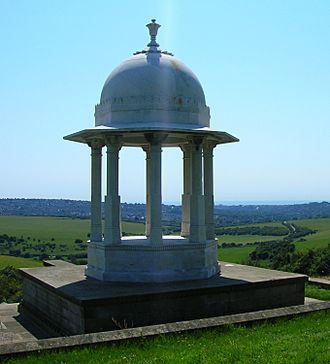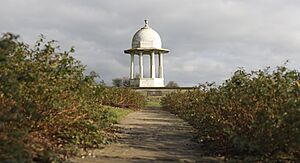Chattri, Brighton facts for kids
Quick facts for kids The Chattri |
|
|---|---|

Looking southwards towards Brighton
|
|
| General information | |
| Type | War memorial |
| Architectural style | Orientalist |
| Location | Brighton and Hove, England |
| Address | Deep Bottom, off A27, Patcham |
| Coordinates | 50°53′3″N 0°8′49″W / 50.88417°N 0.14694°W |
| Elevation | 500 feet (150 m) |
| Construction started | August 1920 |
| Completed | December 1920 |
| Inaugurated | 1 February 1921 |
| Cost | £4,964 (£143 thousand in 2025) |
| Height | 29 feet (8.8 m) |
| Dimensions | |
| Diameter | 9 feet (2.7 m) |
| Design and construction | |
| Architect | E.C. Henriques (Elias Cosmas Henriques) |
| Architecture firm | William Kirkpatrick Ltd, Trafford Park, Manchester |
The Chattri is a special war memorial in the city of Brighton and Hove, England. It sits high up on the South Downs, about 500 feet (150 m) above the city. You can only reach it by a special path called a bridleway. This memorial marks the spot where many Indian soldiers were cremated during the First World War. These soldiers fought for the British Empire. The Chattri is a very important building, listed as Grade II, which means it has special historical and architectural value. In 2017, it became a Fields in Trust Centenary Field to mark 100 years since World War I.
Contents
Why Were Indian Soldiers in Brighton?
During the First World War, India was part of the British Empire. Over 800,000 Indian soldiers bravely fought for the Allied Powers. Many thousands of these soldiers were hurt during the fighting. They were brought to Britain for medical care in special military hospitals.
Three of these hospitals were set up in Brighton. One of the most famous was the Royal Pavilion, which used to be a royal palace. King George V wanted Indian soldiers to be treated at the Pavilion. He thought its unique Indo-Saracenic style would make them feel more at home.
In December 1914, 345 injured soldiers arrived in Brighton by train. They were taken to the hospitals. The King and Queen often visited them. Special care was taken at the Royal Pavilion to provide different foods and meet the cultural needs of Hindus, Sikhs, and Muslims.
What Happened to the Soldiers Who Died?
Most soldiers got better from their injuries. However, some sadly passed away. The 21 Muslim soldiers who died were taken to the Shah Jahan Mosque in Woking, Surrey. They were buried there following Islamic traditions.
The bodies of 53 Hindu and Sikh soldiers were taken to a quiet place high on the South Downs. A special funeral pyre, called a ghat, was built there. Their bodies were cremated, and their ashes were scattered in the English Channel. This was done according to their religious customs. In total, 18 soldiers treated at the Royal Pavilion died. Ten of them were cremated at this special site.
Building the Memorial
In August 1915, soon after the last cremations, people started planning a memorial. A lieutenant from the Indian Medical Service and Brighton's Mayor, Sir John Otter, led this effort. Sir John Otter worked hard on the project. He later chaired Brighton's Indian Memorials Committee.
In December 1915, he suggested building a memorial at the cremation site. He also wanted another memorial in Brighton town centre. Sir Austen Chamberlain, who was in charge of India's affairs, agreed in February 1916.
In July 1916, the land where the cremations happened was given to Brighton County Borough. The India Office also agreed to share the cost of building the memorial. Brighton Corporation, which was the local council, would be in charge of the town centre memorial.
Money was raised in 1917. There were some delays because of the war. But in April 1918, a building company from Manchester was chosen. The main material for the memorial was marble. The marble arrived from Sicily more than a year later. Building work finally began in mid-1920.
A young Indian architect named E. C. Henriques from Mumbai designed The Chattri. He was studying in England. Sir Samuel Swinton Jacob, a famous English architect, helped guide him. Construction started in August 1920 and finished by the end of that year.
Brighton Corporation owned the memorial and was responsible for its care. A small house was built nearby for a caretaker. The total cost of the memorial was £4,964.
The Chattri was officially opened on February 1, 1921. Edward, Prince of Wales, who later became King, unveiled it.
Looking After The Chattri
By the mid-1930s, the memorial was not in good condition. The caretaker had passed away, and no one replaced him. The caretaker's cottage was even torn down. Many people complained about The Chattri's state.
The India Office worked with Brighton Corporation and the Commonwealth War Graves Commission. They wanted to make sure the memorial was properly looked after. They planned a new way to maintain it. They also agreed to make the area around the memorial smaller.
Then, World War II started. The area around The Chattri was quickly taken over by the Army. Soldiers used The Chattri for target practice, and it ended up with bullet holes. After the war, the War Office paid for all the repairs. The Chattri was restored to its original beautiful condition.
From 1951, the Royal British Legion held yearly visits to the memorial. They also helped pay for its upkeep. These visits stopped in 1999. However, the Sikh community has led a similar yearly ceremony since 2000.
The Chattri was officially listed as a Grade II building by English Heritage on August 20, 1971. It is one of many important historical buildings in Brighton and Hove.
What The Chattri Looks Like and Where It Is
The Chattri was built exactly where the funeral pyres were for the 53 soldiers. It is a quiet, peaceful spot on the South Downs. It sits about 500 feet (150 m) above Brighton. From here, you can see the city and the sea.
You can only get to the memorial by a path. This path comes off a bridleway between the A27 Brighton Bypass at Patcham and the Clayton Windmills. The bridleway is part of the Sussex Border Path. The Chattri is at the very edge of Brighton and Hove, near the border with Mid Sussex.
The main part of the memorial is made of white marble from Sicily. It sits on a base of grey stone. This stone base covers three blocks of granite. These granite blocks are placed over the slabs used during the cremations.
The Chattri looks like a tall, domed pavilion. It reaches 29 feet (8.8 m) high to the top point, called a finial. The bottom part is square. Eight columns hold up the dome. These columns start square at the bottom and become octagonal halfway up. The base of the dome is also octagonal.
On the stone base, there is an important message. It is written in English, Hindi, Punjabi, and Urdu. Sir John Otter wrote the words:
To the memory of all Indian soldiers who gave their lives for the King-Emperor in the Great War, this monument, erected on the site of the funeral pyre where Hindus and Sikhs who died in hospital at Brighton passed through the fire, is in grateful admiration and brotherly love dedicated.
Images for kids













